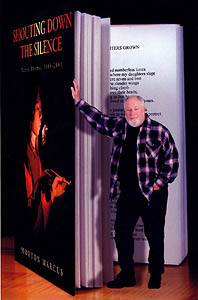![[Metroactive Books]](/gifs/books468.gif)
[ Books Index | Santa Cruz | Metroactive Home | Archives ]
Down With Silence
Poet, teacher, world-class talker Morton Marcus 'shouts down the silence' in his new book of verse
By Mike Connor
MORTON MARCUS is talking to his foot here, an act that should rightfully earn him an amusingly enviable new epithet. Along with 1999 Santa Cruz County Artist of the Year, Retired English and Film Teacher and Nationally Renowned Prose Poet, please add the title Man Who Has Conversations With His Right Foot.
Widely acclaimed for his prose poetry, Marcus has also been laying down some of his most personal musings in verse form and publishing them in literary journals around the country. Coming out on the heels of his latest book of prose poetry, released earlier this year, Marcus' newest volume of poems, Shouting Down the Silence (Creative Arts; $15 paper), is a collection of verse poems written between 1988 and 2001. The lines above are taken from his poem "I Have a Talk With My Right Foot," and it's doubly fitting that this is one of the most rhythmic offerings in the bunch.
"They're some of the most ambitious poems I've written" Marcus enthuses. "It's like a different writer wrote them, because every book I write is different in style and approach than any other."
Shouting is divided into four sections. Part 1, titled "Lost Homes," is full of startlingly intimate poems about his personal life, like the frankly titled "My Aloneness" and "My Daughters Grown," where we find Marcus struggling with how to be a father once the girls are grown. "My wife, / who has similar problems with her father, / says I always imagine my daughters / as little girls asleep in that ancient room, / and only when I portray them as women / will we be able to converse in a manner / that will satisfy us all. She's right, / I'm sure, but she's not a father."
Marcus insists the poems are not all literally autobiographical. "What is individual, I must make universal, because in the end the reader wants to read about his or her life, and how this makes their life more important or more understandable."
Part 2 explores Marcus' travels in the Balkans and Greece. Marcus seems to be at his strongest when he's poking mischievously at the mysteries of the universe, where his poetry is often punctuated by fits of agnostic candor, as in "St. Mark's Cathedral," of which he writes:
Part 3 is, according to Marcus, "the most popular in the book--they're poems about composers, writers and painters and their apocryphal stories, the well-known legends that these writers lived through." Like Robert Schumann's wife, Clara--"I always see her / in her later years, a small German woman / seated before the crouching black beast / of her husband's madness."
Which leads to Part 4, a hodgepodge of poems, some of which represent the most innovative work in the book, both conceptually and lyrically, but feel cramped in verse form. It becomes apparent that the spaciousness of the prose form better fits Marcus' naturally expansive style. But his experimentation with verse pays off, as in the deliciously visceral "Tongue," in which he writes:
"Suffering" tackles the subject head-on and offers a surprisingly Zen answer. But his most breathtaking work appears in the book's namesake, "Shouting Down the Silence," and in "The Boy in the Painting," inspired by the painting that adorns the cover of his book.
In the former, Marcus envisions his ideal death: "To let my last breath go / with the same unthinking assurance / as that breeze sailing down the mountain range"; in the latter, the death of another: "Then an old man come to his final rest / whose last shout is his whole life, a torch-- / thrown against the darkness--that for an instant / slides like a falling star across the night."
[ Santa Cruz | Metroactive Central | Archives ]
Copyright © Metro Publishing Inc. Maintained by Boulevards New Media.
![]()
 When It Rains, It Pours: Morton Marcus is more prolific than a salt mine.
When It Rains, It Pours: Morton Marcus is more prolific than a salt mine.
And truth to tell, I never feel freer than in those moments
when I bump along behind you in your rhythm,
as you stomp and pirouette on the pavement.
And the droning hymns and humble saints
are still barbed in red and green and pray
on walls of translucent light,
so that all who enter here still imagine
they are enclosed in the chamber
of a miraculous, bee-blessed flower
glowing among all the other flowers
in the middle of Paradise.
Dome upon dome,
and God--where is He?
As in a shell game,
the pea, hidden
beneath this one,
that one, or maybe
that other one,
reveals Him to be
nowhere you thought.
Tongue, wild meat rose
surrounded by carrion breath,
our one wing struggling to take flight,
wing in the head the body grips
and won't let fly: Tongue
that hisses, Tongue that sings,
Tongue that flops, that flaps,
that stabs inside its cage.
Morton Marcus will read from 'Shouting Down the Silence: Verse Poems 1988-2001' on Monday, Oct. 7, 7:30pm, at Bookshop Santa Cruz, 1520 Pacific Avenue, Santa Cruz; 423.8371.
From the October 2-9, 2002 issue of Metro Santa Cruz.